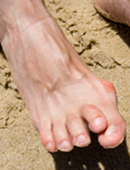185 West End Ave, Lincoln Towers, New York, NY 10023 | Telephone 212.877.3062
Podiatric Surgery
Podiatric surgery is performed to treat many foot and/or ankle conditions that have not responded to more conservative treatments, allowing patients to live without foot or ankle pain. Dr. Antonetz specializes in a wide range of podiatric surgery procedures, including:
Bunion Surgery
 A bunionectomy is the most common form of bunion surgery. It is performed to relieve the pain and discomfort associated with bunions that have not responded to conservative treatment methods. This procedure aims to remove swollen tissue from the big toe joint, remove part of the bone to straighten the big toe, and to correct the alignment of the big toe joint.
A bunionectomy is the most common form of bunion surgery. It is performed to relieve the pain and discomfort associated with bunions that have not responded to conservative treatment methods. This procedure aims to remove swollen tissue from the big toe joint, remove part of the bone to straighten the big toe, and to correct the alignment of the big toe joint.
Recovery from bunion surgery depends on the complexity of the procedure. Some people will be able to walk on their foot immediately after surgery, while others may need to use crutches or a cane and may not be able to walk for a few weeks or longer. Most bunion surgery can be performed using local anesthesia and intravenous sedation, at a hospital outpatient center. Most patients require the use of orthotics after bunion surgery in order to maintain stable and correctly-positioned feet.
Hammertoes
 A hammertoe is a term used to describe a crooked, deviated, or contracted toe. Although the condition usually stems from muscle imbalance, it is often aggravated by poor-fitting shoes or socks that cramp the toes. Patients with this condition often experience pain, swelling, redness and stiffness in the affected toes.
A hammertoe is a term used to describe a crooked, deviated, or contracted toe. Although the condition usually stems from muscle imbalance, it is often aggravated by poor-fitting shoes or socks that cramp the toes. Patients with this condition often experience pain, swelling, redness and stiffness in the affected toes.
Treatment for hammertoes depends on the severity of the condition, but may include home remedies, anti-inflammatory medications, orthotics or surgery for severe cases. Surgery may involve removing a small section of bone from the affected joint through a procedure called arthroplasty. Arthrodesis may also be performed to treat hammertoes, which involves fusing together one of the joints in the toe in order to keep it straight. This procedure requires the use of a metal pin to hold the toe in position while it heals.
Neuromas
A neuroma is a painful swelling of a nerve, usually in the ball or heel of the foot. Symptoms include sporadic pain; burning, tingling or numbness of one or more toes; and a popping sensation when walking. Pain is often soothed by taking weight off the foot, removing your shoe, and massaging the area.
Treatment for a neuroma begins with a combination of cortisone injections to reduce swelling and custom orthotic inserts to correct problematic metatarsal movement. If the nerve is permanently damaged, the patient may decide to undergo chemical destruction of the nerve, have the nerve surgically removed, or freed from the surrounding soft tissues.
Ingrown Toenails
An ingrown toenail is a common condition that involves the corner of the toenail growing into the skin of the toe, causing pain, swelling and infection. This can occur as a result of wearing shoes that are too small or tight, cutting the toenails too short, injury to the toenail or a naturally curved toenail. While this condition can affect any toe, it most commonly affects the big toe. If left untreated, an ingrown toenail is likely to develop an infection and may even require surgery to remove the nail.
Some ingrown toenails can be treated at home by soaking the toe in warm water, and applying an antibiotic cream. When this treatment fails, it is time to visit Dr. Antonetz. Your ingrown toenail may need surgery. Your surgery can be performed in the comfort and convenience of Dr. Antonetz's office, using the latest techniques and local anesthesia. The offending ingrown nail border can be removed. For chronic ingrown toenails, the ingrown side of the nail is removed back to the cuticle. The base of the nail is treated with a chemical to prevent the ingrown part from growing back.
Warts
Plantar warts are noncancerous growths that develop on the soles of the feet as a result of the human papillomavirus (HPV). HPV enters the body through tiny breaks in the skin. These warts appear on the skin as a small, hard bump that may be yellow, white or brown with well-defined boundaries. They may cause pain or tenderness when walking.
Many patients experience pain or embarrassment regarding this condition. Plantar warts can be removed through several different procedures, including cryotherapy (freezing), laser surgery, cantahridin, electro surgery and medication injections. Dr. Antonetz will decide which treatment option is best for you based on your individual condition.
For more information on our Podiatric Surgery services, please contact our office.





